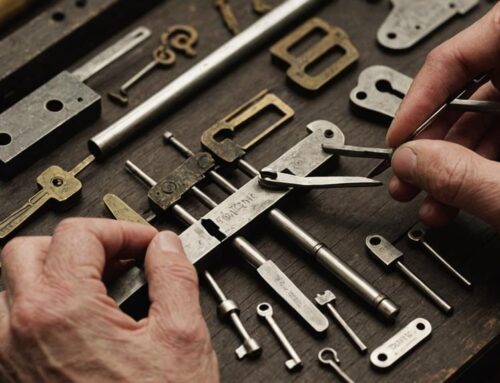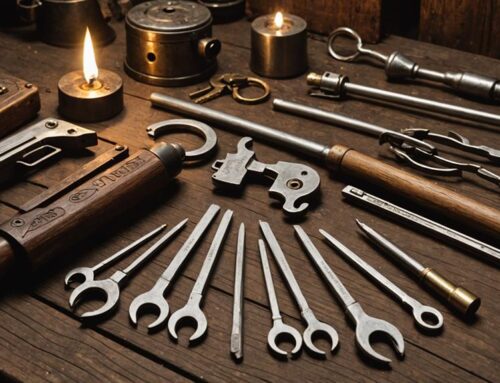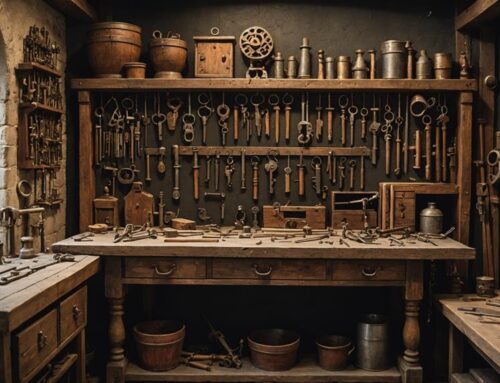Mastering lock picking with a bobby pin involves understanding the mechanics of the lock and practicing technique. Begin by straightening the bobby pin and creating a makeshift tension wrench. Insert the tension wrench into the bottom of the keyway and apply slight pressure. Use the bobby pin to manipulate the pins inside the lock, feeling for pin movement and recognizing when each pin is set. This method applies to various locks, including interior and exterior door locks and padlocks. While this guide provides fundamental steps, the nuances and advanced strategies will refine your skills further.
Key Takeaways
- Straighten and Prepare the Bobby Pin: Straighten the bobby pin and bend a small hook on one end to act as the pick.
- Create a Tension Wrench: Use another bobby pin to create a makeshift tension wrench by bending it into an L-shape.
- Apply Tension: Insert the tension wrench into the bottom of the keyway and apply gentle, consistent pressure.
- Feel for Pin Movement: Use the hooked end of the bobby pin to lift and feel for the pins inside the lock, setting them one by one.
- Practice and Patience: Practice regularly to improve your technique and develop a feel for the lock’s internal mechanics.
Introduction

Picking locks with a bobby pin is an ability that demands both knowledge and precision, making it vital for emergency situations. Understanding the techniques of lock picking can be invaluable, but it is important to emphasize that these skills must be used ethically and responsibly. This guide aims to provide practical insights while underscoring the significance of lawful and appropriate application.
Brief introduction to the topic of lock picking with a bobby pin
For those intrigued by the mechanics of security, lock picking with a bobby pin offers a fascinating glimpse into the intricate world of locks and keys. This method, although seemingly simplistic, demands a solid understanding of advanced techniques to be effective. It is particularly useful in emergency situations where conventional tools are unavailable. Utilizing such an unconventional tool requires not only patience but also a keen eye for detail. The process involves a series of troubleshooting tips to navigate through potential issues that may arise. Low Rate Locksmith, with over 15 years of experience, provides valuable insights into real-life scenarios, demonstrating how mastering this skill can be both practical and educational for enthusiasts and professionals alike.
Importance of understanding lock picking techniques for emergencies
In emergency situations, the ability to understand and execute lock picking techniques can be a critical asset. Whether dealing with lockouts or misplaced keys, mastering bobby pin techniques through diligent practice can offer invaluable quick access. This skill set not only provides practical solutions to unforeseen challenges but also promotes a sense of empowerment.
- Emergency situations: Immediate access during lockouts or when keys are lost.
- Bobby pin techniques: Simple tools that, with practice, can open many doors.
- Quick access: Essential for responding promptly to urgent needs.
- Empowerment: Enhances confidence in handling unexpected lock-related issues.
Disclaimer about the ethical use of lock picking skills
Understanding the ethical implications of lock picking is crucial to guarantee its responsible and legal use. Ethical considerations and legal implications must be at the forefront when practicing lock picking. Responsible use of these skills requires adherence to locksmith regulations and a clear understanding of ethical boundaries. Unauthorized lock picking can result in severe legal consequences, including criminal charges and fines, underscoring the importance of lock picking ethics. Practitioners should follow ethical guidelines and adhere to lock picking etiquette to avoid moral dilemmas and ensure their actions remain within legal frameworks. Always seek thorough legal information to stay informed and compliant with local laws, ensuring your lock picking practices are both responsible and ethical.
The Basics of Lock Picking
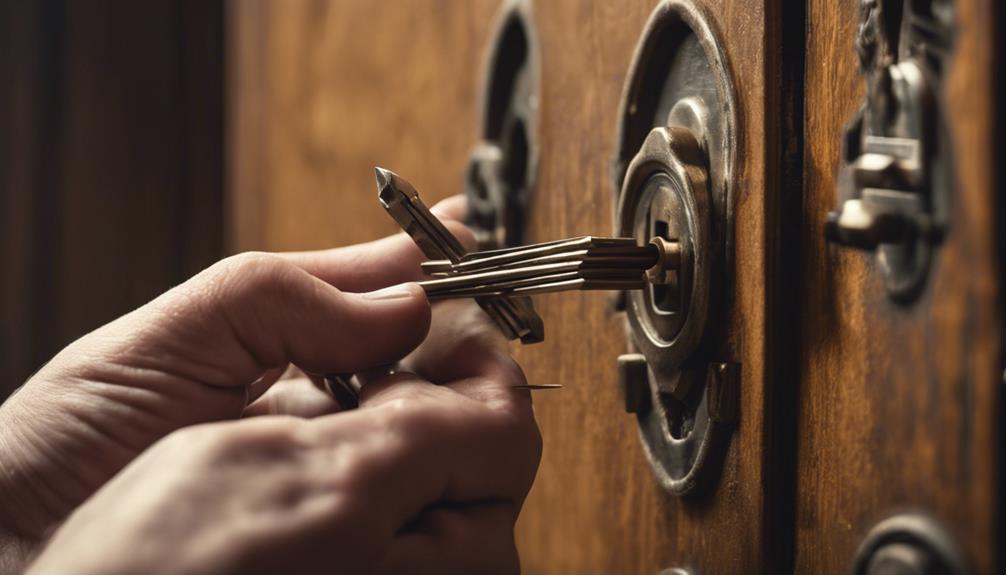
Understanding the fundamentals of lock picking starts with grasping how locks function and identifying the most common types used in residential settings. Historically, lock picking has evolved from a skill of necessity to both a practical and recreational pursuit. This section will provide an overview of the mechanics of locks and an introduction to the basic techniques used in lock picking, particularly with a bobby pin.
Explanation of how locks work
Locks operate by utilizing a series of pins of varying lengths that must align precisely with the shear line to allow the lock cylinder to turn and open. Understanding the internal workings of lock mechanisms is important for mastering lock picking. The interaction between key pins and driver pins within the lock mechanism determines whether the lock can be manipulated.
- Pin interaction: When the correct key is inserted, the key pins and driver pins align at the shear line.
- Shear line: This is the critical point where the pins must align for the cylinder to rotate.
- Lock manipulation: In lock picking, tools are used to mimic the key’s effect on the pins.
- Internal workings: Knowledge of the pin layout and behavior is essential for effective lock picking.
Overview of the different types of locks commonly found in residential settings
In residential settings, a variety of lock types can be encountered, including pin tumbler locks, wafer locks, and disk detainer locks. Pin tumbler locks, the most common residential lock type, feature a series of pins that must align precisely to open. Wafer locks, employing flat wafers instead of pins, require similar alignment for opening. Disk detainer locks use a series of rotating disks with slots that must align. Understanding these residential lock types is essential for effective lock picking methods and identifying security vulnerabilities. A lock mechanism comparison reveals varying complexities and susceptibilities, aiding enthusiasts in DIY lock picking endeavors. Knowledge of these mechanisms forms the foundation for mastering lock picking with tools such as bobby pins.
Introduction to lock picking and its history
Lock picking, an ancient skill with roots tracing back to Egyptian tombs and Roman artifacts, involves the precise manipulation of internal lock mechanisms to achieve unauthorized entry. This practice has a rich history, showcasing how ancient techniques have evolved over millennia to meet modern security challenges. From historical artifacts, we learn that:
- Lock picking history reveals its deep cultural significance.
- Ancient techniques utilized rudimentary tools to bypass early locking systems.
- The evolution of skills has led to the development of sophisticated modern tools.
- Lock picking remains a topic of intrigue, blending technical skill with historical insight.
Understanding the journey of lock picking from past to present offers valuable context for mastering this intricate craft today.
Tools Needed for Lock Picking
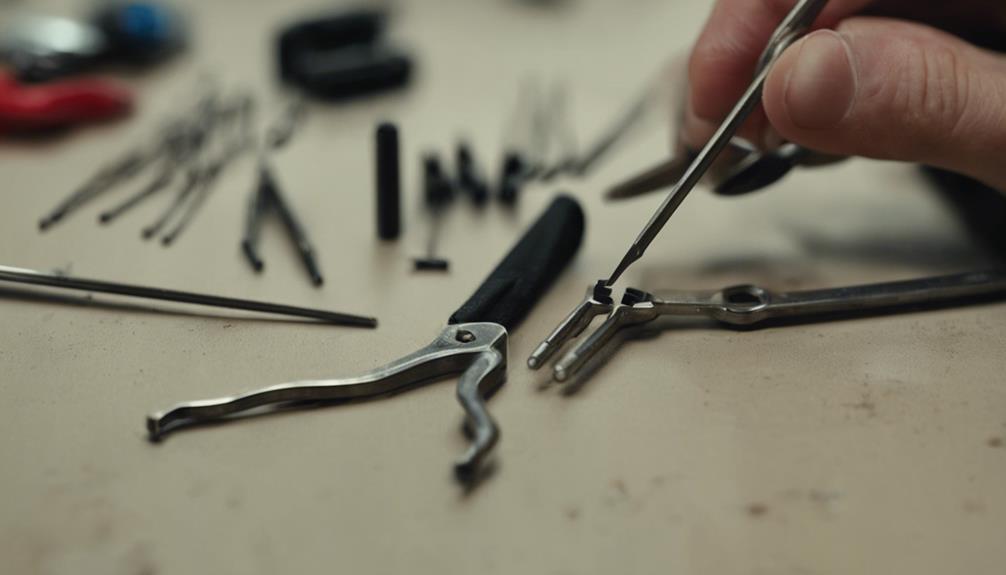
To effectively open doors using a bobby pin, certain essential tools are required. Key items include a bobby pin and a tension wrench, with optional tools such as a paperclip or hairpin for added versatility. This section will guide you through preparing a bobby pin for lock picking and discuss the role of each tool in the process.
List of essential tools for lock picking
A complete lock picking toolkit typically includes bobby pins, paper clips, multi-tools, and custom-made tension wrenches. Mastering lock picking techniques often involves the use of various DIY tools and custom picks. These tools are essential for exploring different lock cracking methods and advanced picking strategies.
Here is a list of essential tools for lock picking:
- Bobby Pins: Versatile and can be manipulated into a variety of picks.
- Paper Clips: Easily shaped into tension wrenches or simple picks.
- Multi-Tools: Handy for on-the-go adjustments and additional picking options.
- Custom-made Tension Wrenches: Precision tools crafted for specific locks and advanced techniques.
These tools provide a solid foundation for anyone looking to investigate the art of lock picking.
Bobby pin
Bobby pins, due to their thin and flexible metal design, are a fundamental component in a lock picking toolkit, providing versatility and effectiveness in manipulating various types of locks. Their malleability allows for significant bobby pin customization, such as removing the plastic coating to enhance flexibility. Despite their simplicity, bobby pins offer robust durability for repeated use in lock picking. While primarily employed for simple locks like padlocks and interior doors, bobby pin applications extend to various lock mechanisms, making them an indispensable tool. Bobby pin alternatives, such as paper clips, can also serve similar purposes. Understanding the bobby pin’s role and limitations is essential for maintaining bobby pin security and achieving successful lock manipulation.
Tension wrench
Integral to the lock picking process, the tension wrench provides the essential pressure needed to turn the lock cylinder and set the pins. This tool is indispensable for successful lock picking, offering precision handling and control over pin manipulation. Mastery of tension control is vital, as improper pressure can impede progress.
Tension wrenches come in various shapes and sizes to accommodate different locks, enhancing the effectiveness of advanced techniques. Key features include:
- Tool variations: Different types and sizes to suit various locks and keyways.
- Precision handling: Allows for meticulous control over the lock cylinder.
- Tension control: Essential for applying the correct amount of pressure.
- Pin manipulation: Works in tandem with a pick to set the pins accurately.
Proper utilization of the tension wrench is foundational to lock picking expertise.
Optional tools: paperclip, hairpin
Paperclips and hairpins serve as versatile alternatives for lock picking, offering flexibility and adaptability for different lock mechanisms. These alternative tools can be fashioned into effective lock picks, providing makeshift options when a bobby pin is unavailable. Each tool’s shape and flexibility can impact the lock picking techniques employed, resulting in varying success levels depending on the lock’s design.
| Tool | Benefits |
|---|---|
| Paperclip | Easily shaped; versatile |
| Hairpin | Flexible yet sturdy |
| Bobby Pin | Readily available; reliable |
| Multi-tool | Designed for precision |
Experimenting with these alternative tools is vital to determine which is most effective for specific locks. Understanding the nuances of each can greatly enhance one’s lock picking proficiency.
How to prepare a bobby pin for lock picking
To prepare a bobby pin for lock picking, one must first remove the plastic coating from the ends using a pair of pliers. This step enhances lock picking precision by creating a more effective tool for maneuvering the lock mechanism. The stripped bobby pin can then be used to address various lock picking challenges, particularly in emergency scenarios.
Here are essential considerations:
- Bobby pin alternatives: Items like paper clips can also be adapted for lock picking.
- Lock picking precision: Removing the plastic coating allows for finer adjustments within the lock.
- Pin tumbler variations: Different locks require different techniques, making a versatile tool essential.
- Emergency scenarios: A well-prepared bobby pin can be a lifesaver in urgent situations.
Proper preparation is key to success in mastering lock picking.
Straightening the bobby pin
Straightening the bobby pin is essential for achieving the precision necessary in lock picking. Proper pin straightening techniques guarantee the bobby pin’s durability and effectiveness. For best results, use your fingers or a flat surface to smooth out the pin, or employ pliers or a multitool for more challenging cases. A straightened bobby pin enhances control and manipulation of the lock’s tumblers, important for precision lock picking. This preparation also helps in preventing breakage during picking, maintaining the tool’s integrity throughout the process.
| Step | Technique | Benefit |
|---|---|---|
| 1 | Finger straightening | Quick and accessible |
| 2 | Flat surface smoothing | Ensures smoothness |
| 3 | Using pliers or multitool | Addresses stubborn bends |
| 4 | Confirm straightness | Essential for precision lock picking |
| 5 | Check durability | Prevents breakage during picking |
Creating a makeshift tension wrench
Creating a makeshift tension wrench is an essential step in the lock-picking process, often utilizing a paper clip or bobby pin bent at a 90-degree angle. This tool is vital for applying consistent pressure to the lock cylinder while manipulating the pins.
- Tension wrench alternatives: Paper clips and bobby pins are commonly used due to their availability.
- Bobby pin effectiveness: With proper bending, they provide the necessary rigidity and control.
- Improvised tools benefits: Easily accessible materials reduce the need for specialized equipment.
- Lock picking challenges: Achieving the right tension is critical for successfully setting the pins without overshooting.
Mastery of precision tensioning techniques can greatly enhance success rates in overcoming lock picking challenges.
Step-by-Step Guide to Picking a Lock with a Bobby Pin
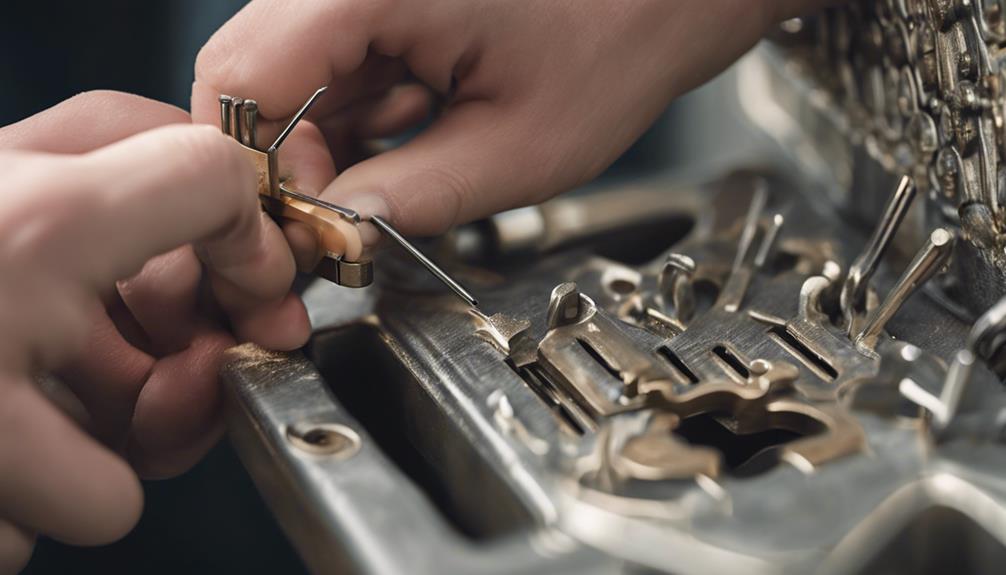
To effectively pick a lock with a bobby pin, begin by creating a tension wrench and a pick from the pin. Insert the tension wrench into the bottom of the keyhole and apply slight pressure while using the bobby pin to lift each pin inside the lock. By carefully manipulating the pins and adjusting the tension, you can successfully open the door, with practice enhancing your technique and efficiency.
Detailed instructions for picking a basic pin tumbler lock
Successfully picking a basic pin tumbler lock with a bobby pin often requires a blend of careful technique and patient practice. To master this skill, one must understand the fundamentals of lock picking techniques and pin tumbler insights. Engaging in DIY locksmithing can be both a practical emergency entry solution and an intriguing hobby. Here is a concise, step-by-step guide:
- Straighten the bobby pin: Bend one end to form a small hook.
- Insert the bobby pin: Use the hooked end to feel for the pins inside the lock.
- Manipulate the pins: Apply gentle pressure to lift each pin to the shear line.
- Practice patience: Fine-tune your bobby pin tricks through repeated attempts.
With dedicated practice, gaining access through doors using a bobby pin becomes a valuable skill.
Inserting the tension wrench
After preparing your bobby pin for manipulating the pins, the next step involves inserting the tension wrench into the bottom part of the keyhole to create the necessary tension. Proper keyhole placement of the tension wrench is vital for effective tension control. This tool mimics the action of a key turning in the lock, providing the pressure needed for pin manipulation. Hold the tension wrench in place while you work the bobby pin to lift the pins. Successful lock picking depends on adjusting the pressure accurately; too much or too little can hinder your progress. Achieving a lock picking balance through careful pressure adjustment is essential for effectively opening the door without oversetting the pins.
Applying the right amount of tension
Achieving the delicate balance of tension is fundamental to successfully picking a lock with a bobby pin. Proper tension control is pivotal as it guarantees that the pins inside the lock remain in their place during the precision picking process. Applying too much tension can obstruct pin manipulation, while too little may fail to engage the pins effectively. Mastering this balance is essential for enhancing your lock-picking skills and understanding lock security. To perfect tension control, practice is indispensable.
- Apply varying degrees of tension to understand the necessary feel.
- Observe the lock’s feedback to adjust your technique.
- Incorporate gradual pressure adjustments to find the best tension point.
- Focus on skill enhancement through consistent practice and observation.
This approach fosters proficiency and reliability in lock picking.
Using the bobby pin to manipulate the pins
To effectively manipulate the pins with a bobby pin, begin by inserting the bobby pin into the keyhole and applying slight pressure to the bottom of the lock. This initial step is important for mastering pin manipulation techniques. With a second bobby pin acting as a tension wrench, gently push up the pins inside the lock using advanced pin picking methods. Focus on pin setting strategies by feeling each pin’s resistance and setting them incrementally. Pin sensitivity training is essential to distinguish the subtle differences in pin heights. Continue applying consistent pressure and refine your techniques for pin manipulation mastery. Practice on various locks to enhance your proficiency and efficiency in accessing doors with a bobby pin.
Tips for beginners to improve their technique
Beginners can enhance their lock picking skills by following a structured step-by-step guide that emphasizes understanding lock mechanisms, practicing on simple locks, and refining their technique with patience and precision. To aid in skill development, it is crucial to implement effective practice techniques and heed expert advice.
- Start with Basic Locks: Begin your learning process on simpler locks before progressing to more complex ones.
- Remove Plastic Coating: This allows for better feedback and control during the technique refinement phase.
- Slow and Steady Movements: Avoid rushing to prevent damage to the lock or breaking the bobby pin.
- Consistent Practice: Regularly practice to develop a tactile sense of the lock’s internal pins.
Feeling for pin movement
Developing the ability to feel for pin movement is a fundamental skill in the lock picking process, requiring a delicate balance of pressure and sensitivity. Sensitivity training is vital for recognizing the subtle feedback from the pins. By applying slight pressure and then releasing it slowly, you can discern the correct pin positioning. Pressure adjustment is key; too much force can jam the pins, while too little will not provide the necessary feedback recognition. Mastering this technique involves consistent practice to develop a tactile sense for the pins’ movements. Understanding how to sense for pin movement is essential for effectively maneuvering the lock and successfully opening it with a bobby pin.
Recognizing when a pin is set
Identifying when a pin is set is pivotal in the lock-picking process, marked by a distinct click or release of resistance. This feedback is essential for successful pin setting and requires keen attention to details. Practicing bobby pin recognition enhances lock feedback sensitivity, aiding skill improvement.
Key indicators that a pin is set include:
- A subtle click: Indicates the pin is correctly positioned.
- Release of resistance: The tension on the bobby pin eases slightly.
- Lock cylinder movement: The lock cylinder may shift subtly.
- Pin stability: The pin remains in place as the cylinder turns.
Mastering these signs is vital for a successful technique, allowing enthusiasts to refine their lock-picking skills effectively.
Unlocking Different Types of Locks with a Bobby Pin
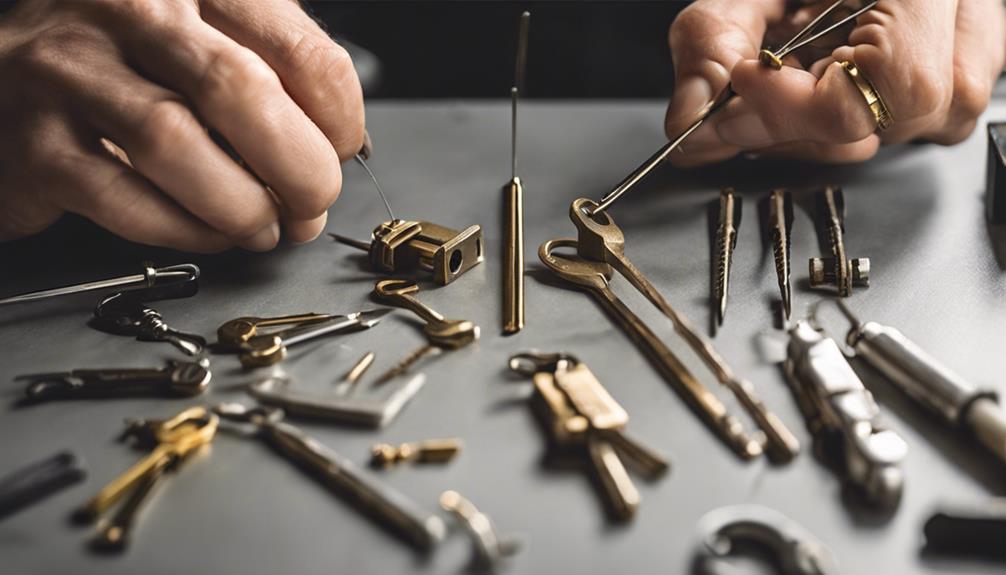
Picking different types of locks with a bobby pin requires understanding the specific characteristics and mechanisms of each lock. From interior door locks like those on bedrooms and bathrooms to exterior locks such as front and back doors, the approach and techniques may vary. Additionally, addressing the unique challenges posed by padlocks and high-security locks, including deadbolts, is essential for achieving successful lock-picking outcomes.
Picking door locks
Mastering the use of a bobby pin to pick various door locks involves understanding the detailed mechanics of different lock types and employing precise techniques to manipulate the pins effectively. Key lock picking techniques hinge on the versatility of the bobby pin, which can be adapted to fit multiple lock designs. Success in this skill demands precision and patience, as each pin must be carefully aligned to open the mechanism without causing damage. By following expert guidance, individuals can build confidence in their ability to pick locks proficiently.
- Lock picking techniques: Learn the step-by-step methods to manipulate lock pins.
- Bobby pin versatility: Adapt bobby pins to fit different lock types.
- Precision and patience: Essential for successful lock picking.
- Expert guidance: Follow seasoned advice to master the craft.
Interior door locks (bedroom, bathroom)
How can one effectively use a bobby pin to open common interior door locks, such as those found on bedroom and bathroom doors? Mastering lock picking techniques for bedroom and bathroom locks involves understanding their simple internal mechanisms. Begin by straightening a bobby pin and creating a small bend at its tip. Insert the bent end into the lock’s keyhole, applying slight pressure to mimic a key. Use a second bobby pin as a tension wrench, maintaining steady torque while manipulating the pins inside the lock. These bobby pin tricks are particularly useful in emergency situations, such as accidental lockouts. With practice and patience, accessing these interior door locks becomes an invaluable skill for ensuring access and safety.
Exterior door locks (front door, back door)
Building on the fundamentals of picking interior door locks, applying these techniques to exterior door locks, such as front and back doors, involves understanding the more complex internal mechanisms and fine-tuning the use of bobby pins for effective manipulation. Advanced techniques are essential due to the heightened security considerations of exterior locks. Practice scenarios using similar locks can help in refining these skills and overcoming common challenges.
- Advanced techniques: Mastering rake and single-pin picking methods.
- Security considerations: Exterior locks often have anti-pick features.
- Practice scenarios: Use old locks to simulate real-world conditions.
- Common challenges: Tighter tolerances and security pins in exterior locks.
Expert tips from seasoned locksmiths can greatly enhance the efficiency and success rate of opening exterior door locks.
Unlocking padlocks
Opening padlocks with a bobby pin involves carefully manipulating the lock’s pins to achieve the correct alignment for disengagement. Effective lock picking techniques require bobby pin mastery, which entails bending the pin into a suitable shape and using it to lift the pins inside the lock. Padlock manipulation necessitates a delicate touch and precision practice to feel for the subtle movements of the pins. By mastering this skill, individuals can gain emergency access when keys are lost or forgotten. Different types of padlocks, including key-based and combination varieties, can be accessed with a bobby pin, provided one understands the lock’s internal mechanics and practices diligently. This technique is a valuable tool in various urgent situations.
Specific challenges with high-security locks and deadbolts
Mastering the intricacies of high-security locks and deadbolts with a bobby pin requires a vital understanding of their complex mechanisms and advanced security features. High-security challenges arise from the additional components designed to thwart unauthorized access, making lock picking complexities more pronounced. Bypassing deadbolts often demands advanced techniques and, occasionally, specialized tools.
- Anti-pick pins or sidebars in high-security locks complicate the picking process.
- Deadbolts are engineered to resist traditional lock-picking methods.
- Specialized tools may be required for manipulating intricate components.
- Attempting to pick without proper knowledge can damage the lock or trigger alarms.
Understanding these elements is essential for anyone attempting to navigate the sophisticated landscape of high-security locks using a bobby pin.
Addressing electronic and smart locks
Due to the sophisticated nature of electronic and smart locks, traditional lock-picking techniques using a bobby pin are generally ineffective. These advanced locks employ digital key authentication and encryption, greatly enhancing electronic lock security and making physical manipulation nearly impossible. Attempting to pick such locks can lead to lock damage risks or trigger security alarms, thereby compromising the system.
| Key Aspect | Description |
|---|---|
| Smart lock vulnerabilities | Generally resistant to traditional lock-picking methods |
| Electronic lock security | Enhanced through encryption and advanced authentication techniques |
| Digital key authentication | Utilizes digital codes, making physical picking methods ineffective |
| Lock damage risks | High risk of damaging the lock or triggering alarms when using improper tools |
For these reasons, it is essential to seek professional locksmith consultation for dealing with electronic and smart locks.
Common Mistakes and How to Avoid Them
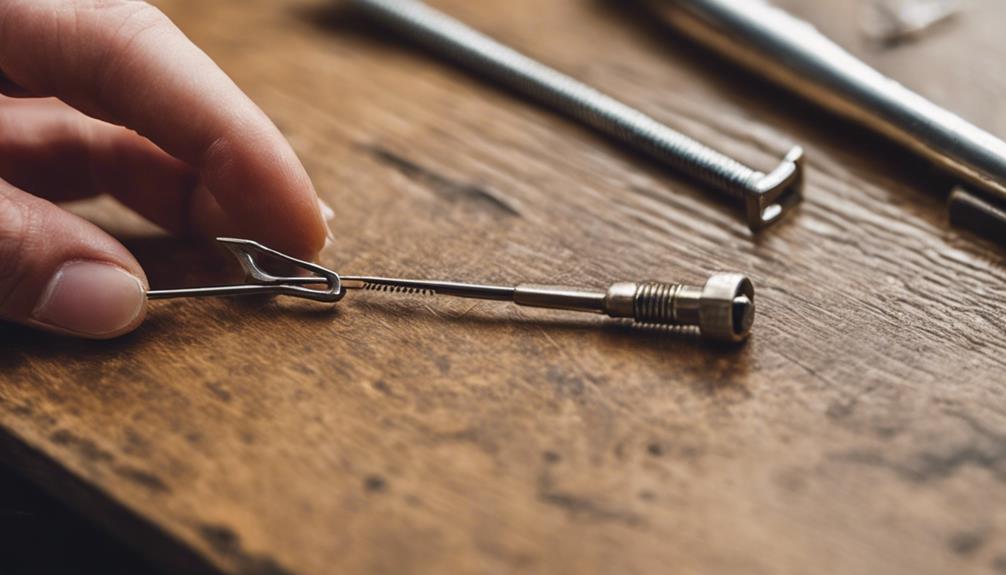
When mastering lock picking with a bobby pin, it is important to recognize and avoid common mistakes such as over-tensioning the lock, applying incorrect pressure on the pins, and misidentifying pin positions. Over-tensioning can easily jam the lock, while improper pressure and misidentified pin positions can hinder the opening process. By addressing these errors, you can enhance your precision and increase your chances of successfully opening doors.
Over-tensioning the lock
Over-tensioning the lock is a common mistake that can greatly impede the lock picking process by causing the pins to bind or jam. Mastering tension control is essential to avoid these pitfalls. Proper tension control allows for smooth pin manipulation and guarantees the internal lock mechanisms operate correctly. Implementing effective opening techniques can mitigate the risk of over-tensioning. Here are some key points to ponder:
- Apply light and consistent pressure on the tension wrench.
- Monitor the feedback from the lock to adjust tension as needed.
- Use advanced troubleshooting to identify and rectify binding pins.
- Practice to develop a keen sense of the lock’s internal mechanisms.
Not using the right amount of pressure on the pins
While mastering tension control is vital to prevent over-tensioning, applying the right amount of pressure on the pins is equally important to avoid common mistakes in lock picking. Incorrect pin pressure can lead to picking mistakes, either by causing the pins to bind or by failing to set them properly. Effective skill development involves maintaining consistent and gentle pressure on the pins, which is essential for the bobby pin technique. Lightly pushing up the pins allows them to set in the correct position without excessive force. Practicing varying pin pressure will refine your ability to gauge the necessary force, ensuring successful lock picking. Balancing lock tension and pin pressure is critical for mastering this intricate skill.
Misidentifying pin positions
One of the most common pitfalls in lock picking is misidentifying pin positions, which can greatly impede successful opening attempts. Errors in pin placement and pin identification can lead to ineffective lock manipulation and potentially result in lock damage. To avoid such mistakes, it is vital to have a clear understanding of the binding order of the pins.
- Pin placement: Guarantee each pin is correctly aligned.
- Lock manipulation: Practice gentle and precise movements.
- Binding order: Learn the sequential order in which pins bind.
- Pin identification: Develop skills to accurately identify pin positions.
Practicing on simpler locks before advancing to more complex ones can significantly reduce the risk of misidentifying pin positions and improve overall lock picking proficiency.
Advanced Techniques and Troubleshooting

In tackling more challenging locks, it is essential to address stubborn mechanisms by experimenting with alternative tools if a bobby pin proves ineffective. Combining a bobby pin with other lock picking instruments, such as tension wrenches or rake picks, can greatly enhance your chances of success. By refining these advanced techniques, practitioners can overcome common obstacles and achieve more reliable results.
Dealing with stubborn locks
Mastering the challenges of stubborn locks demands a blend of advanced techniques and troubleshooting strategies to guarantee successful entry. To tackle these difficult locks effectively, consider the following methods:
- Increased tension: Applying more tension can help set the pins properly.
- Lubricant application: Use a lubricant like WD-40 to ease pin movement.
- Specialized tools: Employ tools such as plug spinners or tubular lock picks for complex locks.
- Obstruction check: Inspect for debris or obstructions inside the lock that may hinder the picking process.
Practicing on a variety of locks will enhance your skills and familiarity with different mechanisms, ensuring you are well-prepared for any stubborn lock you may encounter.
Using alternative tools if a bobby pin isn’t available
When a bobby pin isn’t available, leveraging alternative tools such as paper clips, wire, or small knives can provide effective solutions for lock picking. These improvised tools can be particularly useful in emergency situations where resourceful solutions are necessary. Utilizing paper clips bent into pick shapes or wire as tension wrenches can mimic traditional lock picking techniques. Small knives may also manipulate the lock mechanism when other methods fail. Experimenting with these alternative methods can enhance your versatility and troubleshooting capabilities in various lock picking scenarios.
| Tool | Use Case |
|---|---|
| Paper clips | Bent into makeshift picks |
| Wire | Used as tension wrenches |
| Small knives | Manipulate lock mechanism |
| Pins | Substitute for traditional picks |
| Hairpins | Similar function to bobby pins |
Combining a bobby pin with other lock picking tools for better results
Combining a bobby pin with other lock picking tools, such as a tension wrench or a paper clip, can greatly enhance your control and effectiveness when maneuvering through complex locks. Tool combinations offer advanced techniques that expand flexibility options, allowing you to address a wider range of lock mechanisms. Incorporating these additional tools can greatly aid in skill enhancement.
- Using a tension wrench with a bobby pin provides better control and leverage.
- A paper clip can serve as an auxiliary tool for more flexible pin manipulation.
- Multi-tools like Swiss Army knives add versatility to your lock-picking kit.
- Troubleshooting tips include adjusting tension wrench pressure for stubborn pins.
Safety and Legal Considerations
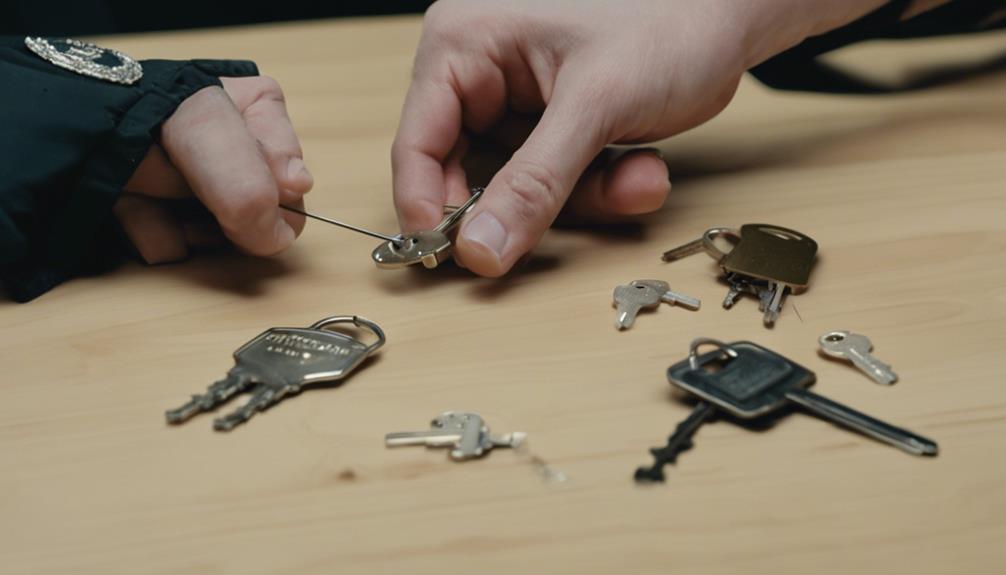
When engaging in lock picking, it is vital to understand the legal implications and guarantee ethical use. Unauthorized lock picking can lead to severe legal consequences, including criminal charges. Always practice lock picking on your own locks or with explicit permission, emphasizing the importance of adhering to local laws and ethical standards.
Understanding the legal implications of lock picking
Understanding the legal implications of lock picking is essential to avoid potential criminal charges and promote responsible practice. Engaging in lock picking without proper knowledge can lead to severe legal consequences. Ethical considerations must be at the forefront, ensuring you only pick locks you own or have explicit permission requirements for.
Consulting locksmith associations can help you stay informed about relevant laws and best practices. Additionally, observing necessary safety precautions can prevent accidents and mishaps.
- Unauthorized lock picking can result in criminal charges.
- Only pick locks with explicit permission.
- Consult locksmith associations for legal guidance.
- Always prioritize safety and legal compliance.
Emphasizing the importance of ethical use
Respecting legal boundaries and practicing ethical use of lock-picking skills is paramount to prevent misuse and promote responsible engagement in this activity. Ethical considerations must be at the forefront, ensuring that these skills are applied only in situations where explicit permission or ownership is confirmed. Skill development should be pursued with an understanding of the legal implications, emphasizing the importance of staying informed about local laws. Safety precautions are essential to avoid unintentional damage, and a thorough risk assessment should be conducted before attempting to pick any lock. This approach not only safeguards personal and public property but also upholds the integrity of the practice, fostering a community of responsible and knowledgeable lock-picking enthusiasts.
Situations where it’s appropriate to pick a lock
Lock picking is important in situations where you are locked out of your own property or have explicit permission from the property owner. It can be a practical solution in lockout emergencies, provided it is executed within legal boundaries. Understanding the legal implications is vital, as unauthorized lock picking can lead to serious consequences. Prior to attempting to pick a lock, consider the following:
- Property access: Make sure you have the right to enter the property.
- Home security: Assess if lock picking is the safest method.
- Locksmith services: Professional assistance might be a safer option.
- Legal implications: Familiarize yourself with local laws to avoid legal trouble.
Always prioritize safety and legality when deciding to pick a lock.
Practical Applications and Real-Life Scenarios
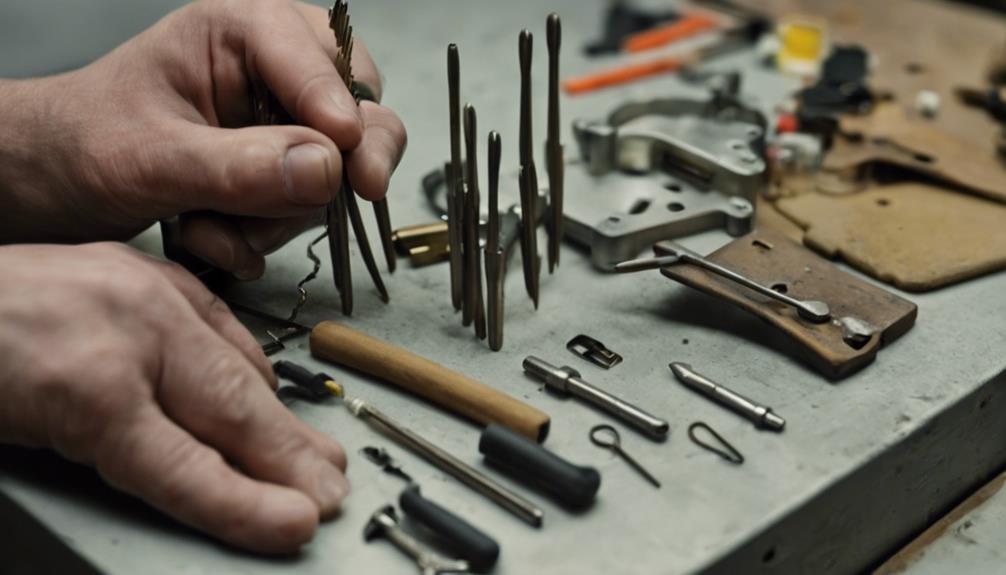
Understanding the practical applications of lock picking with a bobby pin can be invaluable in various real-life scenarios. For instance, this skill can prove essential during emergency lockout situations at home or when assisting neighbors and friends in non-criminal contexts. However, it is important to recognize when to call a professional locksmith to avoid potential damage or legal complications.
Emergency lockout situations at home
In emergency lockout situations at home, utilizing a bobby pin to open a door can be an invaluable skill for quick and cost-effective access. This DIY locksmithing technique can greatly enhance your emergency preparedness, providing immediate solutions without compromising home security. Mastering this skill not only aids in lockout prevention but also offers a sense of self-reliance.
- Quick solutions: Gain rapid access to your home without needing professional assistance.
- Lockout prevention: Equip yourself with skills to handle accidental lockouts efficiently.
- Home security: Understand lock mechanisms, contributing to better overall home security.
- DIY locksmithing: Learn practical skills that can save time and money in urgent situations.
Helping neighbors and friends in non-criminal scenarios
Assisting neighbors and friends with locked doors offers a practical and non-criminal application for demonstrating and refining lock-picking skills. This act of goodwill enhances community relationships and fosters trust building, as individuals rely on each other in times of need. It presents an excellent skill showcase, allowing practitioners to apply their knowledge in real-world scenarios. The practical applications of such assistance extend beyond mere problem-solving; they serve as valuable experiences that further hone one’s expertise. By helping neighbors and friends, individuals not only support their local community but also reinforce their proficiency in a positive and constructive manner, illustrating the beneficial aspects of mastering lock picking.
When to call a professional locksmith
Often, calling a professional locksmith becomes essential when faced with emergency situations like being locked out of your home or car. While DIY solutions such as lock picking can be useful, there are scenarios where professional help is indispensable. Professional locksmiths offer numerous advantages:
- Expertise with various types of locks and security systems
- Availability of specialized tools to avoid property damage
- 24/7 services for immediate assistance
- Ability to address complex lock issues efficiently
Attempting to pick a lock without adequate knowledge can lead to damaged locks or compromised security systems. Therefore, in critical situations, relying on a professional locksmith ensures a swift, secure resolution, safeguarding both your property and peace of mind.
Linking to Other Locksmith Services
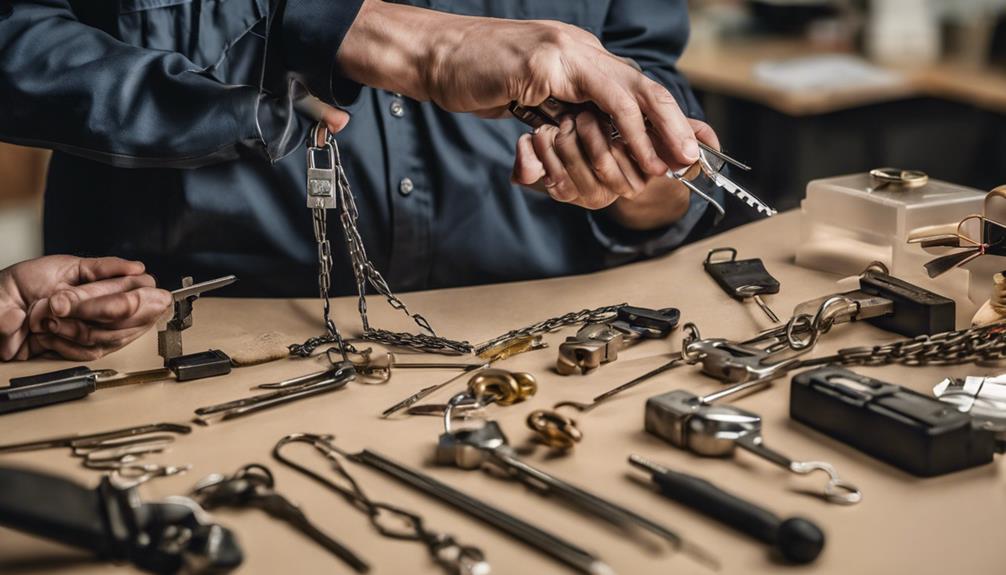
While mastering lock picking with a bobby pin can be a useful skill, it’s important to recognize the wide range of services offered by Low Rate Locksmith. From residential lockouts and lock changing services to high-security lock installations, their expertise extends far beyond simple DIY techniques. For detailed guides and thorough service information, customers can explore the extensive resources available on their website.
Low Rate Locksmith offers a wide range of locksmith services, including lock picking, key cutting, rekeying, and lock installation, ensuring all your lock-related needs are met with expertise and reliability. With over 15 years of experience, their team excels in various door opening methods and rekeying techniques. This dedication to quality service makes them a trusted choice for any locksmith requirement.
- Locksmith services: All-encompassing solutions for residential, commercial, and automotive needs.
- Key cutting: Precision key duplication for a variety of lock types.
- Rekeying techniques: Efficient rekeying services to enhance security without changing locks.
- Lock installation: Professional installation of high-security locks for top-notch protection.
Trust Low Rate Locksmith for all your locksmith needs, delivered with unparalleled expertise.
Residential lockouts
Residential lockouts are a prevalent issue that require the expertise of professional locksmith services to guarantee safe and efficient access to one’s home. Low Rate Locksmith, with their extensive experience, offers thorough lockout solutions tailored to address such emergencies. Their locksmith expertise ensures that homeowners can regain emergency access without compromising home security. Equipped with specialized tools and techniques, these professionals can open doors swiftly and efficiently, minimizing any potential damage. The quick response times provided by 24/7 locksmith services ensure that residents can rely on immediate assistance during unforeseen lockout situations. By leveraging professional locksmith services, homeowners can secure their property and restore access promptly, enhancing overall home security.
Lock changing services
Professional lock changing services are critical for maintaining robust security in both residential and commercial properties. With over 15 years of experience, Low Rate Locksmith excels in providing thorough lock changing solutions tailored to enhance security and peace of mind. Their expertise extends to various lock changing techniques, ensuring that properties are safeguarded against unauthorized access.
- Security upgrades: Replacing outdated locks with advanced, more secure options.
- Key duplication services: Offering precise key duplication to guarantee convenient access.
- Lock maintenance tips: Providing guidance on maintaining locks for peak performance.
- Commercial property security: Specializing in securing commercial establishments with robust lock systems.
These services are designed to meet the unique needs of both residential and commercial clients, ensuring long-term security and reliability.
High-security lock installations
High-security lock installations, incorporating advanced features such as biometric access control and anti-pick technology, provide an unparalleled level of protection. These sophisticated locks are engineered to deliver maximum security against various intrusion methods, including picking, drilling, and bumping. Implementing these systems necessitates advanced techniques, specialized tools, and extensive expert training to guarantee proper installation and functionality. Locksmiths trained in high-security lock installations are well-equipped to handle these complex systems, ensuring robust protection for homes, businesses, and valuable assets. Utilizing such high-security measures offers peace of mind and a superior defense against unauthorized access, making them an essential investment for those seeking to enhance their security infrastructure.
Providing links to detailed guides and service pages
Low Rate Locksmith’s website offers an extensive assortment of detailed guides and service pages designed to assist both novices and experts in mastering various lock picking techniques. Their resources cover a wide array of topics, ensuring thorough learning opportunities for all users.
- Lock picking techniques: Step-by-step instructions on using bobby pins, paper clips, and multi-tools.
- DIY tools: Guidance on crafting and utilizing DIY vibrating lock picks and tension wrenches.
- Safe cracking methods: Insights into using magnets and brute force techniques to crack safes.
- Luggage protection: Information on the vulnerabilities of TSA locks and alternative security measures for safeguarding your belongings.
These guides not only enhance practical skills but also broaden understanding of security vulnerabilities and protective measures.
Conclusion

To sum up, mastering basic lock-picking skills, such as using a bobby pin, requires patience and meticulous practice. It is imperative to exercise these skills responsibly and within legal boundaries. For further resources and professional guidance, we encourage you to explore the extensive services offered by Low Rate Locksmith.
Recap of key points and importance of mastering basic lock picking skills
Mastering basic lock picking skills is essential for both emergency preparedness and enhancing one’s understanding of security mechanisms. These skills offer a range of benefits:
- Emergency preparedness: Being able to open doors in urgent situations can be lifesaving.
- Lock picking techniques: Gaining proficiency in various methods guarantees versatility.
- Security knowledge: Understanding how locks operate increases overall security awareness.
- Valuable skill: This expertise can be applied in numerous scenarios, providing practical advantages.
Encouragement to practice responsibly and ethically
While mastering basic lock picking skills offers numerous benefits, it is crucial to practice these techniques responsibly and ethically. Ethical dilemmas can arise when these skills are misused, leading to significant legal considerations and consequences. Responsible practice involves only attempting to pick locks that you own or have explicit permission to access. Addressing privacy concerns is paramount; unauthorized lock picking infringes on others’ rights and can lead to criminal charges. Practicing ethically guarantees that you avoid damaging locks and respect the property of others. By understanding the potential consequences of misuse, enthusiasts can maintain a positive and lawful approach to this craft, ultimately fostering a secure environment for everyone.
Invitation to explore more locksmith services and resources on Low Rate Locksmith’s website
Discover a wealth of locksmith services and educational resources by visiting Low Rate Locksmith’s website. With over 15 years of experience, Low Rate Locksmith offers detailed insights and professional services designed to enhance your locksmith skills and home security. Their website features an array of resources tailored for both beginners and seasoned practitioners.
- Locksmith training programs to build foundational skills.
- Advanced techniques for accessing complex security systems.
- Thorough guides on installing and maintaining security systems.
- Strategies for handling urgent situations efficiently and safely.
Explore these resources to master the art of lock picking and beyond. Whether for professional development or personal interest, Low Rate Locksmith provides invaluable tools and knowledge to help you succeed.
Additional Resources
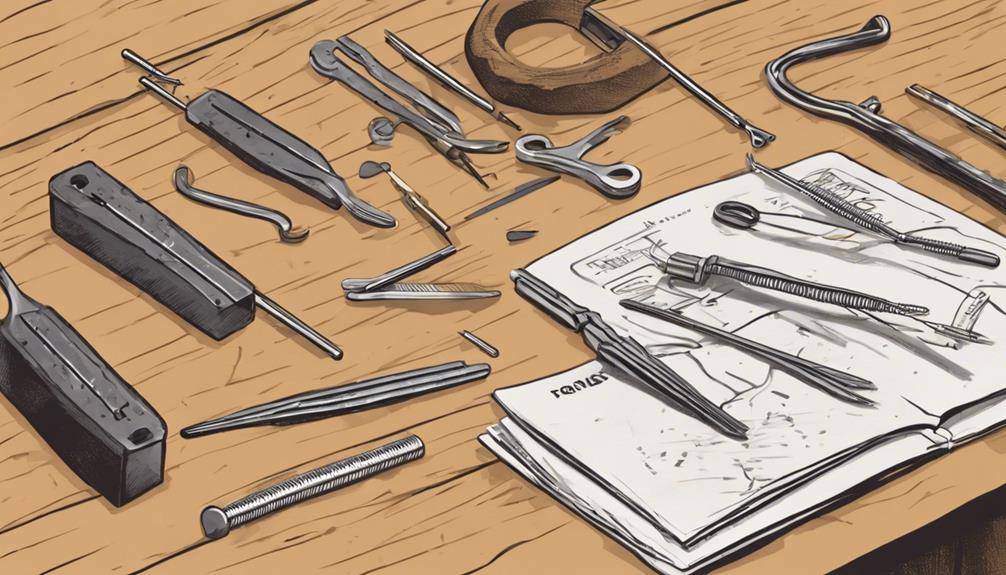
For those looking to expand their knowledge and skills in lock picking, a variety of additional resources are available. Consider exploring suggested readings and video tutorials that offer in-depth guidance. Additionally, links to locksmith courses and certifications can provide structured learning opportunities and professional development in this specialized field.
Suggested reading and videos for further learning
Enhancing your lock picking skills is best achieved by exploring a variety of quality resources, including online tutorials, detailed books, and instructional videos from seasoned experts. These resources offer insights into advanced techniques, troubleshooting tips, and further learning opportunities essential for mastering the craft.
- Recommended reading: Books such as ‘Practical Lock Picking’ by Deviant Ollam and ‘Lock Picking: Detail Overkill’ by Solomon provide thorough guides.
- Video tutorials: Channels like LockPickingLawyer and HelpfulLockPicker on YouTube offer step-by-step instructions.
- Online tutorials: Websites and forums like Lock Picking 101 are invaluable for learning advanced techniques and sharing troubleshooting tips.
- Interactive learning: Engaging with lock picking communities and attending workshops can greatly enhance your practical skills.
Links to locksmith courses and certifications
Pursuing locksmith courses and certifications is an excellent way to formalize your lock picking skills and gain professional recognition in the field. Online certifications from institutions like the Locksmith Institute and Penn Foster Career School offer structured learning paths. For those seeking hands-on apprenticeships, partnering with experienced locksmiths provides invaluable practical experience. Specialized training programs are available for niche areas such as automotive locksmithing and safe technician skills. Additionally, certifications from organizations like the Associated Locksmiths of America (ALOA) can greatly enhance your credibility. Engaging in locksmithing forums and attending workshops also offer networking opportunities, allowing you to connect with industry professionals and stay updated on the latest techniques and trends.
Frequently Asked Questions
How to Unlock a Master Lock With a Bobby Pin?
How does one open a Master lock with a bobby pin? To begin, create a tension wrench by bending the bobby pin and inserting it into the bottom of the keyhole to apply tension. Next, straighten another bobby pin to use as a pick for pin manipulation. Employ the rake technique by scrubbing the pins inside the lock mechanism. Maintain tension until the pins align, mimicking the action of a bump key, thereby opening the lock.
How to Pick a Lock With a Bobby Pin Step by Step?
To pick a lock with a bobby pin, understand bobby pin mechanics and lock pin anatomy. First, prepare a bobby pin and a tension wrench. Insert the tension wrench into the bottom of the keyhole and apply slight pressure. Next, insert the bobby pin, using a raking technique to lift the pins. Adjust tension as needed. Finally, lock lubrication may facilitate smoother pin movement, enhancing the overall effectiveness of the process.
How to Unlock an Interior Door With a Bobby Pin?
To open an interior door with a bobby pin, imagine engaging in a delicate dance. Start by applying lock lubrication to ease the process. Utilize the tension technique by inserting a tension wrench into the keyhole and applying slight pressure. Shape the bobby pin for durability, and gently manipulate the interior door mechanisms. Through consistent practice sessions, you’ll develop the finesse required to navigate this intricate task successfully.
How Do I Pop Open a Master Lock?
To pop open a Master Lock, understanding its lock anatomy and history is essential. By employing tension techniques, you can manipulate the internal components. Various lock types require different approaches, but generally, inserting a tension tool and a pick, such as a bobby pin or paper clip, can help. Despite security improvements over the years, some models remain vulnerable. Mastering these techniques involves practice and a deep knowledge of the lock’s mechanisms.
Conclusion
In summation, mastering the art of lock picking, particularly with a bobby pin, necessitates a confluence of precision, technique, and a nuanced understanding of various lock mechanisms. The insights provided herein, drawn from over 15 years of industry expertise, elucidate the essential tools and methods required for proficiency in this craft. Whether as a hobby or a practical skill, the knowledge gained fortifies one’s comprehension of security systems, ultimately empowering individuals with a valuable and unique skill set.


